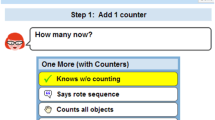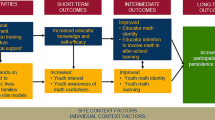Abstract
Using a cluster randomized trial, we investigated the effects of mathematics professional development on student achievement in elementary schools. Pairs of schools were matched on prior mathematics; percentage of students receiving free or reduced-price lunch and percentage of limited English proficient students were randomly assigned to two groups. One received professional development on mathematics that focuses on diagnosing student thinking and the other received professional development on formative assessment. Student-level achievement data (pretest and posttest performance on a standardized test of mathematics) were nested within grades and schools and analyzed using mixed-effects multi-level linear modeling. The results indicate students in schools that were provided the mathematics professional development had greater mathematics achievement than students in schools in a control condition. The effect held across grade levels.

Similar content being viewed by others
Notes
We use Bruner’s seminal work to describe the importance of all three representations and to distinctively highlight “iconic” representations. Current researchers use the words, physical (for enactive), representation (for iconic), and abstract (for symbolic). The word representation is too generic. We want to focus on visual iconic representations in more detail.
References
Ball, D. L. & Hill, H. C. (2008). Mathematical knowledge for teaching (MKT) measures: Mathematics released items 2008.
Ball, D. L., Hill, H. C., & Bass, H. (2005). Knowing mathematics for teaching: Who knows mathematics well enough to teach third grade and how can we decide? American Educator, 14–46.
Ball, D. L., Thames, M. H., & Geoffrey, P. (2008). Content knowledge for teaching: What makes it special? Journal of Teacher Education, 59(5), 389–407.
Borasi, R. (1987). Exploring mathematics through the analysis of errors. For the Learning of Mathematics, 7(3), 2–8.
Borasi, R. (1994). Capitalizing on errors as “springboards for inquiry”: A teaching experiment. Journal for Research in Mathematics Education, 166–208.
Bray, W. S. (2013). How to leverage the potential of mathematical errors. Teaching Children Mathematics, 19(7), 424–431.
Brendefur, J., & Frykholm, J. (2000). Promoting mathematical communication in the classroom: Two preservice teachers’ conceptions and practices. Journal of Mathematics Teacher Education, 3(2), 125–153.
Brendefur, J., Strother, S., Davidson, S., & Gates, C. (2015). Guide to using the developing mathematical thinking (DMT) observation tool. Northwest. Northwest Regional Educational Laboratory of Education Northwest.
Bruner, J. S. (1964). The course of cognitive growth. American Psychologist, 19(1), 1–15.
Carpenter, T. P., & Lehrer, R. (1999). Teaching and learning mathematics with understanding. In E. Fennema & T. Romberg (Eds.), Mathematics classrooms that promote teaching for understanding (pp. 19–32). Lawerance Erlbaum Associates.
Cobb, P. (2000). Conducting classroom teaching experiments in collaboration with teachers. In R. Lesh & A. Kelly (Eds.), Handbook of research design in mathematics and science education (pp. 307–334). Lawrence Erlbaum.
Depaepe, F., Verschaffel, L., & Kelchtermans, G. (2013). Pedagogical content knowledge: A systematic review of the way in which the concept has pervaded mathematics educational research. Teaching and Teacher Education, 34, 12–25.
Doerr, H. M. (2006). Examining the tasks of teaching when using students’ mathematical thinking. Educational Studies in Mathematics, 62(1), 3–24.
Dolk, M., & Fosnot, C. T. (2006). Minilessons for operations with fractions, decimals, and percents addition and subtraction. Heinemann.
Driscoll, M. P. (2004). Psychology of learning for instruction (3rd ed.). Allyn & Bacon.
Forman, E. A. (2003). A sociocultural approach to mathematics reform: Speaking, inscribing, and doing mathematics within communities of practice. In J. Kilpatrick, W. G. Martin, D. Schifter, & National Council of Teachers of Mathematics (Eds.), A research companion to principles and standards for school mathematics. National Council of Teachers of Mathematics.
Freudenthal, H. (1973). Mathematics as an educational task. Springer.
Freudenthal, H. (1991a). Revisiting mathematics education. Kluwer.
Freudenthal, H. (1991b). Revisiting mathematics education: China lectures.
Garet, M. S., Porter, A. C., Desimone, L. M., Birman, B. F., & Yoon, K. S. (2001). What makes professional development effective? Results from a national sample of teachers. American Educational Research Journal, 38(4), 915–945.
Gersten, R., Dimino, J., Jayanthi, M., Kim, J. S., & Santoro, L. E. (2010). Teacher study group: Impact of the professional development model on reading instruction and student outcomes in first grade classrooms. American Educational Research Journal, 47(3), 694–739.
Gooding, A., & Stacey, K. C. (1992). Communication and learning in small group discussion. Paper presented at the Seventh International Congress of Mathematical Education, Quebec.
Gravemeijer, K., & van Galen, F. (2003). Facts and algorithms as products of students’ own mathematical activity. In J. Kilpatrick, W. G. Martin, & D. Schifter (Eds.), A research companion to principles and standards for school mathematics (pp. 114–122). NCTM.
Guskey, T. R. (2000). Evaluating professional development. Corwin Press.
Hiebert, J., & Carpenter, T. P. (1992). Learning and teaching with understanding. In D. A. Grouws (Ed.), Handbook of research on mathematics teaching and learning (pp. 65–97). Macmillan.
Hiebert, J., Carpenter, T. P., Fennema, E., Fuson, K. C., Human, P., Murray, H., et al. (1996). Problem solving as a basis for reform in curriculum and instruction: The case of mathematics. Educational Researcher, 25(4), 12–21.
Kennedy, M. M. (2016). How does professional development improve teaching? Review of Educational Research, 86(4), 945–980.
Larsen, S., & Bartlo, J. (2009). The role of tasks in promoting discourse supporting mathematical learning. In L. Knott (Ed.), The role of mathematics discourse in producing leaders of discourse (pp. 77–98). Information Age Publishing.
Ma, L. (1999). Knowing and teaching elementary mathematics: Teachers' understanding of fundamental mathematics in China and the United States. Mahwah, NJ: Lawrence Erlbaum Associates, Inc.
Moschkovich, J. (1999). Supporting the participation of English language learners in mathematical discussions. For the Learning of Mathematics, 19(1), 11–19.
Moschkovich, J. (2012). Mathematics, the common core, and language: Recommendations for mathematics instruction for ELs aligned with the Common Core. Understanding language: Commissioned papers on language and literacy issues in the Common Core State Standards and Next Generation Science Standards, 17–31.
National Council of Teachers of Mathematics. (2000). Principles and standards for school mathematics. National Council of Teachers of Mathematics.
NCTM. (2000). Principles and standards for school mathematics. National Council of Teachers of Mathematics.
Newmann, F. M., & Associates. (1996). Authentic achievement: Restructuring schools for intellectual quality. Jossey Bass.
NGA. (2010). Common core state standards for mathematics. National Governors Association and the Council of Chief State School Officers.
NRC. (2001). Adding it up: Helping children learn mathematics. National Academy Press.
NWEA. (2011). Technical manual for measure of academic progress for primary grades. Retrieved from Portland, OR.
Pinheiro, P. O., Lin, T.-Y., Collobert, R., & Dollár, P. (2016). Learning to refine object segments. Paper presented at the European conference on computer vision.
Prescott, A., Bausch, I., & Bruder, R. (2013). TELPS: A method for analysing mathematics pre-service teachers' Pedagogical Content Knowledge. Teaching and Teacher Education, 35, 43–50.
R Core Team. (2016). R: A language and environment for statistical computing [Computer software]. The Comprehensive R Archive Network. Available from https://www.R-project.org/
Romberg, T. A., & Kaput, J. J. (1999). Mathematics worth teaching, mathematics worth understanding. In E. Fennema & T. A. Romberg (Eds.), Mathematics classrooms that promote understanding. Lawrence Erlbaum Associates.
Shulman, L. (1986). Those who understand: Knowledge growth in teaching. Educational Researcher, 15(2), 4–14
Siegler, R. S. (2003). Implications of cognitive science research for mathematics education. In J. Kilpatrick, W. G. Martin, & D. E. Schifter (Eds.), A research companion to principles and standards for school mathematics. (pp. 219–233). Reston, VA: National Council of Teachers of Mathmatics.
Simon, M. A., & Tzur, R. (2004). Explicating the role of mathematical tasks in conceptual learning: An elaboration of the hypothetical learning trajectory. Mathematical Thinking and Learning, 6(2), 91–104.
Snijders, T. A. B., & Bosker, R. J. (2012). Multilevel analysis: an introduction to basic and advanced multilevel modeling. Thousand Oaks, CA.
Treffers, A. (1987). Three dimensions: A model of goal and theory description in mathematics instruction–The Wiskobas project. Reidel.
Webb, N. L. (2002). Depth-of-knowledge levels for four content areas. Language Arts, 28(March).
Xu, R. (2003). Measuring explained variation in linear mixed effects models. Statistics in Medicine, 22, 3527–3541.
Yoon, K. S., Duncan, T., Lee, S. W.-Y., Scarloss, B., & Shapley, K. L. (2007). Reviewing the evidence on how teacher professional development affects student achievement: National Center for Educational Evaluation and Regional Assistance, Institute of Education Sciences, US Department of Education.
Funding
The research reported here was supported by the Institute of Education Sciences, U.S. Department of Education, through R305A120265 to Keith Thiede, Jonathan Brendefur, Richard Osguthorpe, and Jennifer Snow.
Author information
Authors and Affiliations
Corresponding author
Ethics declarations
Disclaimer
The opinions expressed are those of the authors and do not represent views of the Institute or the U.S. Department of Education.
Rights and permissions
About this article
Cite this article
Brendefur, J., Champion, J., Strother, S. et al. The Effects of Mathematics Professional Development on Elementary Student Achievement. Int J of Sci and Math Educ 20, 1079–1097 (2022). https://doi.org/10.1007/s10763-021-10184-z
Received:
Accepted:
Published:
Issue Date:
DOI: https://doi.org/10.1007/s10763-021-10184-z




